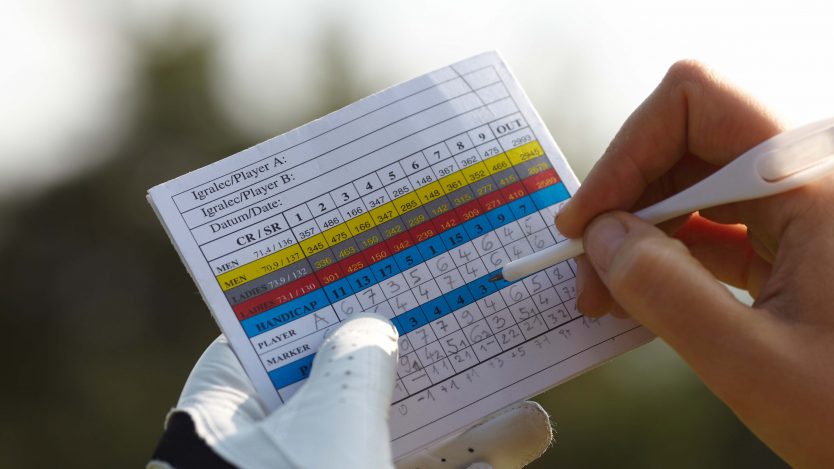After a winter of waiting, the way we play our golf will shift again on April 1. What difference will the WHS alterations make?
This article is part of GCMA Insights – topical content for golf industry professionals, discussing the things that matter to those who work in golf clubs.
Are you finally starting to get used to that big board full of numbers in your clubhouse? It’s about to come down.
By that, I mean your club will need to physically remove it – at least in its current form. It’s going to be out of date.
If you’ve been doing mental twists trying to work out the allowances for betterball and fourball match play competitions, get ready to reach for the calculators once more. The way you do that is changing.
And if you’ve sneakily earned a few pots by avoiding individual competitions and cashing in on team events (shame on you), you’re about to be halted in your tracks.
Big changes to the World Handicap System are about to hit home at the start of next month, and they’re going to have a significant impact on how we play golf.
To say WHS has had a difficult birth would be underselling the fury of its detractors. Change always comes with criticism – we’re hard-wired as a species to be suspicious of it – but there is something about the digits given to us to hit a ball round a field that seems to torment even the most otherwise calm of us.
If it doesn’t feel that long since we started getting to grips with WHS, it’s because it isn’t. Some of you won’t even have looked at your new handicap index before the spring of 2021 and now it’s all change again. It’s normal to feel a bit disorientated.
But with the next review of handicapping not due until 2028, there is a chance for things to settle down and the tweaks that will apply from April 1 should help to do that.
The introduction of Course Rating minus Par might seem complicated at first but it really isn’t. If the par of your course is lower than the course rating, you’ll get more shots than you did. If it’s higher, you’ll lose shots.
Get involved in the debate.
To join the GCMA, click here, or to organise a call with a call with a member of the GCMA team, just complete the form below.
The biggest benefit is it’s par, rather than Course Rating, which now becomes the scoring standard.
So, to give the example of Stableford, if you shoot 36 points you will – as you did pre-WHS – have played to your handicap.
We all, even if it is on a sub-conscious level, equate two points per hole as par. If we shoot to our course’s par, we believe we’ve done our job.
It was confusing to explain this wasn’t the case depending on the Course Rating.

You can play a blame game as to why it wasn’t introduced in GB&I in 2020 when WHS arrived. Handicap chiefs say they wanted to keep things simple, as they tried to explain WHS Index, Course Handicaps, and Playing Handicaps to golfers in one go.
It’s here now, though, and it should resonate better with golfers.
Something had to be done about fourball betterball events. It seems like every club has a tale about a team who can’t stop winning pairs trophies but are nowhere to be seen when there is an individual competition on the calendar.
WHY JOIN THE GCMA?
Membership of the GCMA unlocks a network of like-minded professionals, provides you with support in your professional and personal development, and provides you with a multitude of benefits. Whether that’s the tools that will help you to excel in your profession, or a wide range of services to support your wellbeing, signing up to the GCMA is joining a community.
Yes, handicap committees could try and pick off the most blatant, and competition committees could stipulate entry requirements which demanded a certain number of scores.
But the first was hardy foolproof, and invited conflict, while the second prevented genuine players who might have time commitments from being able to play.
The new ways won’t be a free-for-all. There are stringent conditions that need to be met before a 4BBB score can appear on a player’s record.
The early indications, though, are they will catch the players they are looking for – giving clubs more confidence their events are being won by the best competitors, not by those who’ve manipulated handicaps to their advantage.
People have seriously misunderstood Expected Score. The new way of calculating what happens when a hole is not started does not mean players can just walk off the course if they’re trying to protect a good number, or if they’re having a bad round.
You’ll still need a valid reason to not have played a hole. ‘It was raining’ doesn’t count.
Handicap committees will still need to be vigilant but the old net par, and net par plus one, version wasn’t a hugely accurate measurement – and could discriminate against nine-hole rounds that were scaled up (you would only get 17 points for your phantom back 9).
Being measured by the Expected Score of players of your ability, on a course of standard difficulty, is a better way of assigning numbers when holes can’t be started.
Competitions over fewer than 18 holes, and the chance for shorter courses to become rated, will all also add to playing opportunities.
As we approach the fourth anniversary of WHS, it feels like the system is just getting started. It’s to be hoped these additions will finally start to smooth a transition for all golfers.
This article is part of GCMA Insights – topical content for golf industry professionals, discussing the things that matter to those who work in golf clubs.
Get involved in the debate. To join the GCMA, click here, or to organise a call with a member of the GCMA team, just complete this form and we’ll be in touch!
Enquiries
"*" indicates required fields



